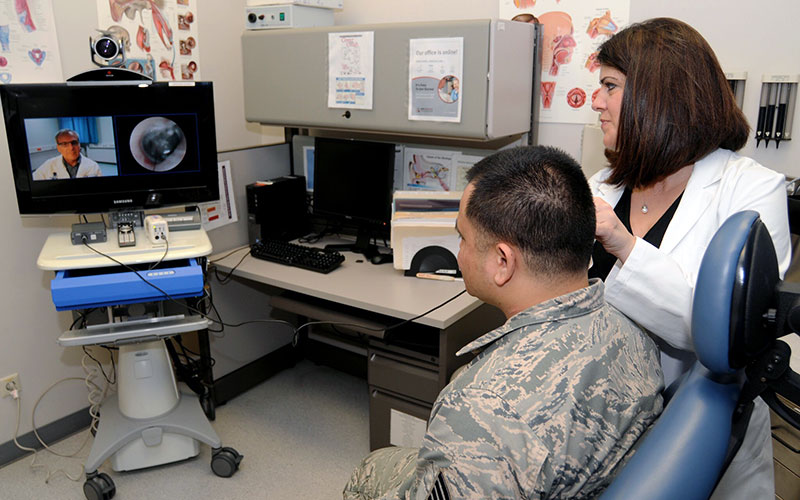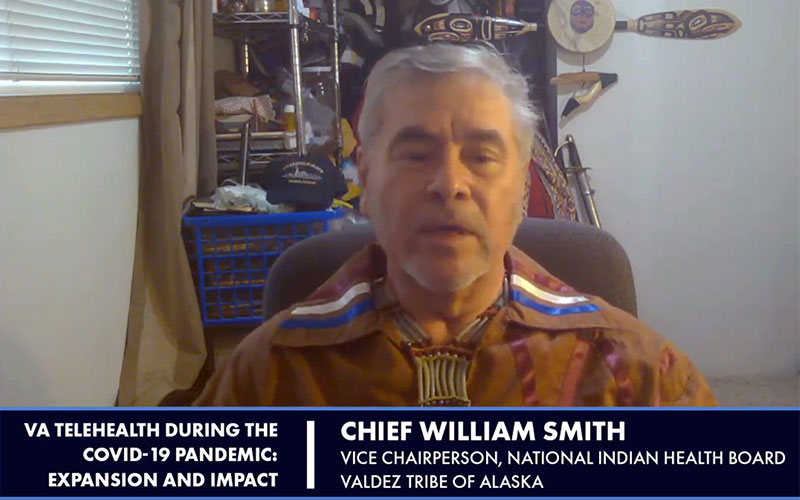- Slug: BC-CNS-Telehealth Champions,1650
- 4 photos, graphic and audio story available (thumbnails, captions below)
- Eds: Third in the “COVID-19 in Indian Country” series.
By Allie Barton
Cronkite News
PHOENIX – Before COVID-19, Joshuaa Allison-Burbank spent his days traversing the Navajo Nation, stopping at homes, libraries and schools to provide speech therapy and reading support for children with developmental disabilities.
Now he sits at a computer in Waterflow, New Mexico, grappling with how to keep helping kids whose families may have no internet or laptops or iPhones – or, if they do, are coping with far more than a telehealth appointment that may or may not go off as planned.
“Back when we were seeing people face to face, it was a matter of, ‘I’ll be at your house or you’ll be at this place at a certain time.’ Now it’s: ‘We need to set up this meeting between everything else that’s happening in your life … and how are we going to do this?’” said Allison-Burbank, who is Navajo and Acoma and runs his own private therapy group, Little Moccasins Education Services.
“So it’s a whole new normal when it comes to delivery of clinical therapy services,” he said. “And it’s tough.”
This new normal has also become a lifeline.
As the coronavirus pandemic wears on, medical providers across the U.S. are moving to telehealth – prompting calls for more funding for infrastructure and technology in Indian Country to remedy disparities that can make long-distance care impossible.
Stacy Bohlen, CEO of the National Indian Health Board, said COVID-19 has accelerated the expansion of telehealth in American Indian and Alaska Native communities, allowing those in more remote areas to receive much-needed medical and behavioral health care.
Since the Indian Health Service expanded its telehealth system in April, the agency has averaged over 750 videoconference visits per week, which is 10 times more visits than before the rollout.
Bohlen notes, however, that Native American communities have not “had the luxury of the years of evolving” into a highly functional system with the capability of providing such services on a widespread scale.
“We have many, many households in many communities that are not wired. They don’t have fiber optics. They don’t have broadband. Some don’t have the internet at all, and those that do, especially in the more remote areas, it is often very unreliable,” she said.
“This is part of another, I would say, pandemic as far as Indian Country is concerned – which is the chronic underfunding of our infrastructures.”
A vast digital divide
Tribal lands remain some of the least-connected areas in the U.S. to internet service.
A 2019 assessment conducted by Arizona State University’s American Indian Policy Institute found that 18% of tribal reservation residents had no internet access at home, while 31% said their connection was spotty or nonexistent.
That research echoes other studies that for years have pointed to a digital divide between Indian Country and the rest of the U.S.
A 2019 Federal Communications Commission report found that while just 6% of the overall population lacked high-speed internet, 26% of those in rural areas and 32% of those living on tribal lands lacked such connectivity.
In Arizona, more than 160,000 people living on tribal lands have either “unserved or underserved” telecommunication infrastructure needs and often must use schools, libraries or other community entities to access the internet, according to a 2018 state report on broadband.
In Alaska, home to 229 of the nation’s 574 federally recognized tribes, there are regions in the state that still have no broadband service or are serviced by only one provider, and sometimes even that isn’t good enough. The village of Stebbins, in western Alaska, recently experienced a weeklong internet outage, according to the Alaska Native Health Board.
The board said that in many ways “Alaska has paved the way in telehealth” out of sheer necessity, but a lack of providers and technology in some areas is stunting that progress.
With over 80% of Alaska’s communities accessible only by plane or boat, the ability to meet with a medical provider through telehealth could greatly improve early detection of medical conditions and help eliminate long-standing health disparities.
William Smith is the acting chairperson of the National Indian Health Board and a board member of the Valdez Native Tribe in Valdez, Alaska, a fishing village of about 4,000 people, including about 750 tribal members.
Although the town is accessible by road and has reliable electricity, the Valdez Tribe still does not have the capability to offer telehealth services to members at its tribal building because it lacks the necessary equipment and personnel, Smith said.
Smith himself had to travel over 300 miles to Anchorage to a Veterans Affairs hospital just to be seen by his doctor in Idaho through telehealth. The physical exam was administered by a nurse practitioner on-site, and Smith said, “I was able to see more parts of my body than I’ve ever seen before” through scans his doctor analyzed from afar.
“Telehealth for behavioral health and mental health, and a secured system for telehealth, would really enhance and help what’s going on – especially with COVID, because not everybody can make the trip up to Anchorage,” Smith said.
In an attempt to remedy gaps in coverage during COVID, the FCC is dispersing $200 million to health care providers to buy technology needed for telehealth visits and improve broadband connectivity. In May, the Navajo Nation received nearly $1 million to fund home care and remote monitoring services for low-income, elderly and high-risk patients.
No providers in Alaska received funds from that program, but more than $800,000 went to the Alaska Native Tribal Health Consortium under a U.S. Department of Health and Human Services effort to increase funding to telehealth resource centers during COVID. The consortium provides care for some 180,000 Alaska Natives and American Indians in the state.
Smith has been testifying on these issues in hopes of drawing attention to the needs of his people and those across Indian Country.
On July 17, he addressed the U.S. Commission on Civil Rights, urging the federal government to provide at least $1 billion in emergency funding to the Indian Health Service to fund infrastructure and health advancements.
“The U.S. must recast the approach to tribal nations and break new ground to truly honor the trust and treaty obligations,” Smith testified. “We can do better. We must. This pandemic is far from over, and the opportunities to find new ways forward are greeting us.”
Connecting through care and culture
Colby Hagen is Oglala Lakota and Crow Creek Sioux and grew up on South Dakota’s Pine Ridge Indian Reservation. Living now in Lawrence, Kansas, she’s a speech pathologist who serves Native children in communities across the country.
Even before the pandemic, she saw some of her 65 young patients via telehealth. Her overall caseload has dwindled to about 20 children since COVID-19 struck.
“It’s been very hard to reach students and families,” she said. “A lot of them are already in survival mode, and this pandemic has really just put a lot of stress and a lot of burden on families.”
Because so many of the families she works with don’t have access to a computer or reliable Wi-Fi at home, she’s sent home learning packets so that parents can work on skills with their children before her check-in calls.
For those she does see via telehealth, one bonus is more direct communication with caregivers, be they parents, grandparents or siblings.
“It’s really helped to build a connection in general,” she said. “I’m Lakota, and that’s not the community I serve. I serve other tribal communities, so being able to listen to what’s important to them or their tribal stories is helpful for me in my practice.”
Hagen and Allison-Burbank said speech pathology is an especially challenging specialty to translate over to telehealth, given that therapeutic exercises require tactile modeling and demonstrations.
Allison-Burbank has sought to work around that by sending books to his patients ahead of time so they can read together virtually, by using electronic books to help with interaction, or by sharing documents so he and his patients can follow along at the same time.
“It requires a lot more work and a lot more creativity, but there’s ways to get around that,” he said. “You do what you can with what you have.”
Allison-Burbank has been raising funds to send books that focus on Diné concepts to families across the Navajo reservation. He said helping his kids read and comprehend these culturally relevant materials while at home provides a “language rich environment.”
“By being at home and remembering that home is a safe place, is a place of learning, we as educators and health care professionals can build on some of those things now, and even maybe this shifts how we teach Native children in the future,” he said.
For now, Hagen plans on continuing telepractice into the fall to respect tribes that have asked to limit travel on and off reservations. When she eventually returns to in-person appointments, she said she would consider wearing a clear mask so the children can see her mouth, although it’s hardly a perfect solution.
Allison-Burbank is still working with his families remotely, too, but is considering what sort of protective equipment would be required for home visits or whether meeting patients in a place where social distancing is possible, like a parking lot, would be better.
Despite the many challenges and strides that still need to be made, telehealth, he said, has provided an important bridge to those who would otherwise be even more isolated and without help.
“There have been many cases where being able to see someone familiar, face to face, is just good,” he said. “It’s good medicine to be able to connect with someone, even if it is remotely and through a video screen.”
For more stories from Cronkite News, visit cronkitenews.azpbs.org.
^__=
Erica Taylor, nurse director for the telehealth program at Landstuhl Regional Medical Center in Germany, demonstrates using the telehealth cart otoscope to conduct an exam. As COVID-19 persists, medical providers are moving to telehealth – prompting calls for more resources in Indian Country to make this care possible. (Photo by Phil Jones and Army Medicine/Creative Commons)
In this screenshot, William Smith, of the Valdez Native Tribe in Alaska, testifies before the U.S. House subcommittees on health and technology modernization about the need for more telehealth to help fight COVID-19. Smith has been working to draw attention to the lack of infrastructure in Indian Country during the pandemic. (Photo courtesy of the National Indian Health Board)
Alaska’s Valdez Native Tribe is one that doesn’t have the ability to offer telehealth services to members from its tribal building. William Smith, a tribal board member, had to travel over 300 miles to Anchorage to a hospital just to be seen by his doctor in Idaho through telehealth. (Photo courtesy Valdez Native Tribe)
Joshuaa Allison-Burbank, who is Navajo and Acoma, runs his own private speech therapy group. He used to spend his days traveling across the Navajo reservation providing care. Now he’s using telehealth. “It’s a whole new normal when it comes to delivery of clinical therapy services.” (Photo courtesy of Little Moccasins Education Services)



